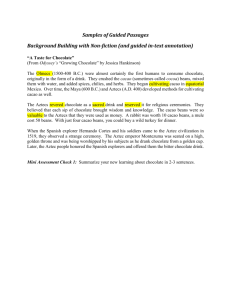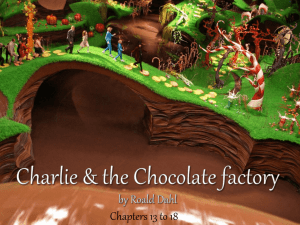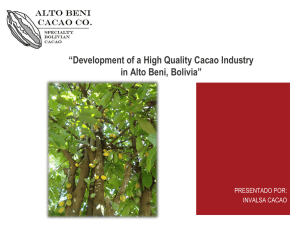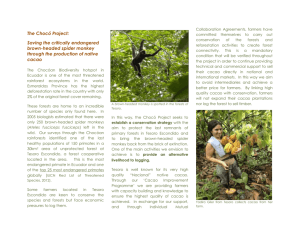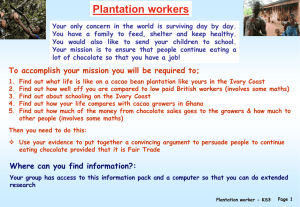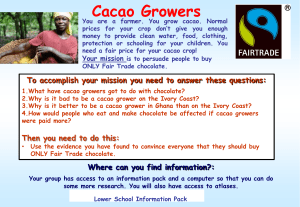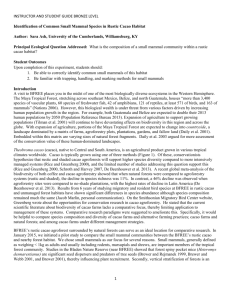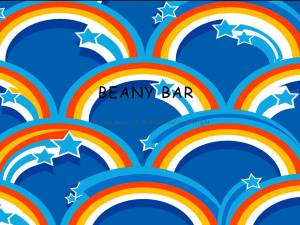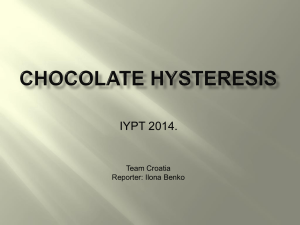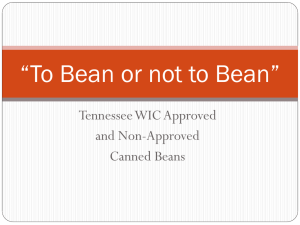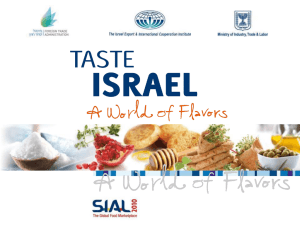Find out where in the world cacao beans are grown
advertisement
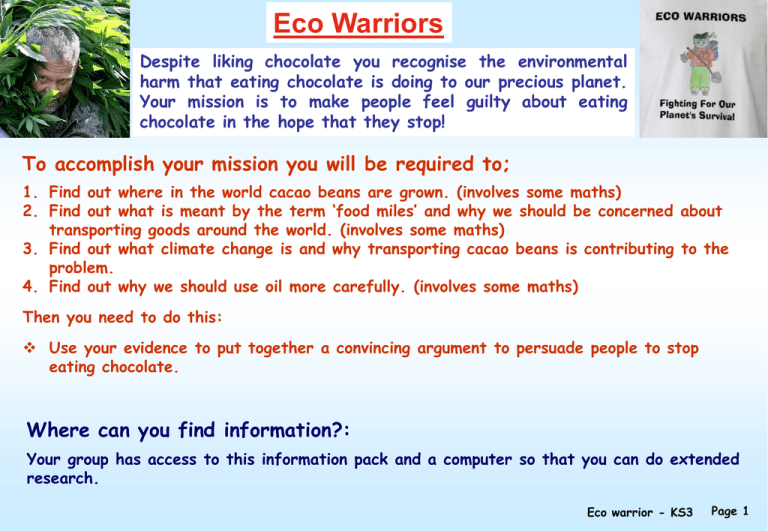
Eco Warriors Despite liking chocolate you recognise the environmental harm that eating chocolate is doing to our precious planet. Your mission is to make people feel guilty about eating chocolate in the hope that they stop! To accomplish your mission you will be required to; 1. Find out where in the world cacao beans are grown. (involves some maths) 2. Find out what is meant by the term ‘food miles’ and why we should be concerned about transporting goods around the world. (involves some maths) 3. Find out what climate change is and why transporting cacao beans is contributing to the problem. 4. Find out why we should use oil more carefully. (involves some maths) Then you need to do this: Use your evidence to put together a convincing argument to persuade people to stop eating chocolate. Where can you find information?: Your group has access to this information pack and a computer so that you can do extended research. Eco warrior - KS3 Page 1 1. Find out where in the world cacao beans are grown Cacao beans grow in pods on the cacao tree. More than 20 species of the cacao tree exist and they grow only within 20 degrees of the equator. Each tree thrives under the canopy of the rainforest. For every two pounds of chocolate made, around 500 cacao beans are used. That means around 14 cacao pods are required to make 1kg of chocolate. The majority of the production of cacao is from the Ivory Coast but a huge portion also comes from South America. Today, the top cacao bean-producing countries include: the Ivory Coast, Indonesia, Nigeria, Ghana, Brazil, Malaysia, Equador, Cameroon, Togo, Mexico, Papua New Guinea and the Dominican Republic. The most abundant of all cacao tree species is the Theobroma cacao tree, which has to grow for three years before it sprouts cacao pods. A cacao tree can produce about 2,000 pods every year. The pod or fruit is ridged and resembles a miniature football. The pods grow from the branches that stick out of the tree’s trunk. The pods enclose a white sticky pulp with about 30 to 40 seeds inside. The white pulp is sweet and tart at the same time. Seeds straight out from the pod will taste bitter when bitten. This feature of the plants is part of a perfect cycle: forest animals like to eat the fruit but they cast the seeds to the ground, allowing new seedlings to sprout and grow. . The Criollo tree is grown in Mexico but its yield is fairly low. Its beans are some of the best quality in the world and are in very high demand. Criollo beans are usually mixed with various types of cacao seeds for making different types of chocolate, including diabetic chocolate. (information continued on next page) Eco warrior - KS3 Page 2 1. Find out where in the world cacao beans are grown (continued) Country Ivory Coast Annual production (tons) 1,300,000 Ghana 720,000 Indonesia 440,000 Cameroon 175,000 Nigeria 160,000 Brazil 155,000 Ecuador 118,000 Dominican Republic 47,000 Malaysia 30,000 Others 350,000 World total % of world production 3,500,000 100% Suggested tasks: 1. Complete the table by working out the missing tonnage for the Ivory Coast and then calculate the percentages. 2. Produce a bar or pie chart showing either the tonnage or % produced by each country. 3. Print off a map of the world and mark on it the cacao bean producing countries. Eco warrior - KS3 Page 3 2. Find out what is meant by the term ‘food miles’ and why we should be concerned about transporting goods around the world When you eat a pineapple, drink a cup of coffee or bite into a bar of chocolate, you are enjoying tropical food grown thousands of miles from Britain. The distance that food travels from the farmer who produced it to the consumer who eats or drinks it is measured in 'food miles'. ‘Food miles’ has become accepted as a convenient indicator of sustainability and has led to a general movement towards local production and local consumption in order to minimize them. As a country the UK has a lot of work to do as the ‘food mile’ problem is getting worse. In 1991, the UK was 75% self-sufficient in food. Today it is just 62% self-sufficient! Agriculture and food now account for nearly 30 per cent of goods transported worldwide. This travel adds substantially to the carbon dioxide emissions that are contributing to climate change - which is why food miles matter. The carbon dioxide emissions come from burning oil and oil related products and these fuels cannot be replaced once they have been used. This reliance upon food miles is a difficult chain to break. We are all now addicted to chocolate and other products (which are never going to be grown in the UK) that are imported. So what can we do? Overall, the best rule for reducing food miles and their environmental damage is to shop as locally as possible, for locally-produced food that is in season. In a recent experiment in Fife, a group of people tried what has become known as ‘The Fife Diet’, and found that it was quite possible to have a healthy and varied diet using only food produced within a hundred mile radius, although they had to go without a lot of luxury items – including chocolate. (information continued on next page) Eco warrior - KS3 Page 4 2. Find out what is meant by the term ‘food miles’ and why we should be concerned about transporting goods around the world (continued) Chocolate is made from the cacao bean. The cacao tree needs good soil, plenty of rain and a warm, humid climate. The leaves are poisonous, but the cacao pods contain seeds. These seeds (also called 'beans') contain cocoa butter, which is the main ingredient in chocolate. The cacao pods have to be harvested by hand, and on small farms the whole family helps to get the pods off the trees. They use sharp knives called machetes (mah-shet-ees) to cut them off or they knock them down with sticks. Then they split the pods open, get the seeds out and cover them with the fruit pulp. The pulp ferments and drains away. Then the beans are left to dry in the sun for about five days, The farmer then sells the beans to a company that makes chocolate. The beans should be dry for shipment (the vast majority by sea) to the United States and Europe. Traditionally exported in jute bags, over the last decade the beans are increasingly shipped in 'Mega-Bulk' bulk parcels of several thousand tonnes at a time on ships, or in smaller lots of around 25 tonnes in 20 foot containers. Shipping in bulk significantly reduces handling costs; shipment in bags, however, either in a ship's hold or in containers, is still commonly found. Suggested tasks: 1. Find out approximate distances from each of the cacao bean producing countries to the UK; present the information in an appropriate table. Use the data presented on page 3. Eco warrior - KS3 Page 5 3. Find out what climate change is and why transporting cacao beans is contributing to the problem Our climate is changing, largely due to increases in human produced greenhouse gases like carbon dioxide. Greenhouse gases absorb heat from the sun in the atmosphere and reduce the amount of heat escaping into space. This extra heat has been found to be the main cause of observed changes in the climate system over the 20th century. These changes include increases in global average air and ocean temperature, widespread melting of snow and ice and rising global sea levels. The extra heat in the climate system has other impacts, such as affecting atmospheric and ocean circulation, which influences rainfall and wind patterns. Another serious impact of increases in the greenhouse gas carbon dioxide is ocean acidification. Around a quarter of human-produced carbon dioxide is absorbed by the oceans. As the carbon dioxide dissolves in sea water it forms a weak carbonic acid, making the ocean more acidic. There are early indications that some marine organisms are already being badly affected by ocean acidification. The Earth’s atmosphere is like a blanket that keeps us warm. Having too much carbon dioxide in the atmosphere is like adding more and more blankets! (information continued on next page) Eco warrior - KS3 Page 6 3. Find out what climate change is and why transporting cacao beans is contributing to the problem (continued) Climate change is happening – right now! The world’s leading scientists believe that a warmer planet may result in some or all of the following events happening. Which ones might have the biggest impact on all our lives? Loss of sea ice, Shrinking glaciers, Rivers dry up, Biting insects spread to northern countries, Food shortages because of crop failure, Less fresh water in some parts of the world, More intense heat waves, Much less rain in some parts of the world, More intense heat waves, Less snow cover, Larger areas of land become deserts, More damaging storms, The oceans become less able to support life. What can we do about climate change? Some changes to the climate are inevitable, but there is still time to have a positive influence on the future. Start by reducing the ‘food miles’ – stop eating chocolate and other food products sourced from a long way away (remember that carbon dioxide is produced when fuels like oil and coal are burnt). Did you know? 1 tonne of carbon dioxide emitted could lead to a 0.0000000000015 Celsius rise in global temperatures Suggested tasks: 1. Look at the list of possible effects of climate change and decide which are the 3 most important. 2. Produce a poster to show people why these 3 effects might be bad for us. 3. Find an example of a marine food chain (or web) and use it to explain why it will be a problem for us if the oceans become less able to support life. 4. Find out what other gases are classed as greenhouse gases. A small family car driven about 12,000 miles a year produces 3 tonnes of carbon dioxide each year Eco warrior - KS3 Page 7 4. Find out why we should use oil more carefully We take many things for granted in this world. For example electricity at the flick of a switch, central heating, hot water and foreign holidays and the freedom to travel the roads in cars. These are things that we should cherish and not take for granted. Why? Generating the electricity to heat and light a chocolate factory, moving goods (like cacao beans) by ship and driving to the shops to buy chocolate burns fossil fuels like coal and oil – diesel and petrol are made from oil. In addition to creating carbon dioxide when we burn these fuels we are also using them up – once they have gone they have gone! So, when you buy a bar of chocolate just think about all the fossil fuels that have been used up in making it and moving it. The debate about when the world will run out of oil is very complicated. For example; 1. 2. 3. 4. cars now use less fuel but there are more cars on the road; developed countries are trying to use less fossil fuels but this is offset by developing countries who want a similar standard of living as the developed ones; as supplies of fossil fuels decline the price of them increases which then reduces demand; as the price rises oil companies want to start exploring riskier parts of the world – the Antarctic and Arctic being obvious examples. (information continued on next page) Eco warrior - KS3 Page 8 4. Find out why we should use oil more carefully (continued) So, should we be concerned – just when will oil run out? You can work it out yourself from these very simplified figures (and please remember that it is a lot more complicated than this!!) There are an estimated 1,300,000,000,000 barrels of proven oil reserve left in the world’s major oil fields. The world currently uses 85,000,000 barrels of oil a day. So, you can work out for yourself how long the proven oil reserves might last – but please remember that this is very much simplified! Suggested tasks: 1. Work out when we might start to run out of oil – you will need to draw a table like the one shown and work out how much is left at the end of each year. 2. Draw a graph of your results (it will be a straight line). 3. Produce a poster to show people what a life without oil might mean to us. Oil is sold across the world in barrels Year end 2010 2011 Oil reserves (Barrels) 1,300,000,000,000 Reduce each year by 85,000,000 x 365 2012 continue Eco warrior - KS3 Page 9
